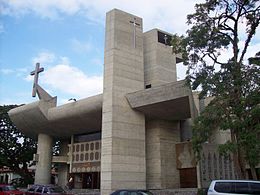|
San Felipe, Venezuela
San Felipe (Spanish pronunciation: [saɱ feˈlipe]) is the capital city of Yaracuy, Venezuela. San Felipe is located in the Central-Western Region, Venezuela. The city is an important urban, industrial, commercial and transportation center of Venezuela. San Felipe is the seat of the Roman Catholic Diocese of San Felipe, Venezuela. HistoryIn 1693, Spanish settlement began in the area that is now San Felipe with the foundation of the town of Cerrito de Cocorote. Like all towns in the region at the time, Cerrito de Cocorote was under the jurisdiction of the city of Nueva Segovia de Barquisimeto. In 1710, the town was destroyed on orders from the authorities of Nueva Segovia de Barquisimeto[why?]. Despite this, the town was rebuilt within several years, causing the Captain General to again order its destruction. In 1721, the town's inhabitants returned to rebuild it after receiving the authority to do so. Despite this, the authorities of Nueva Segovia de Barquisimeto set fire to the town, destroying it for the third time. Despite the destruction of their town, the former inhabitants of Cerrito de Cocorote still wished to be independent of Nueva Segovia de Barquisimeto. They received the support of Fray Marcelino de San Vicente, who helped them obtain a Royal Certificate from King Philip V of Spain to establish a town independent from Nueva Segovia de Barquisimeto. On November 6, 1729, the same day the villagers had received the Royal Certificate, they began the reconstruction of their town in the Valle Hondo region, naming it San Felipe El Fuerte in homage to Philip V of Spain. The city expanded in subsequent years, until it was destroyed by the 1812 Caracas earthquake on March 26, 1812. After the earthquake, the town's remaining inhabitants again rebuilt it. GeographySan Felipe is located in the foothills of Cerro Chimborazo, in Bolívar, Yaracuy. The city is located on a hill, with its avenues being on steep slopes, with its streets being less inclined. In the upper part of the city is the José Antonio Anzoátegui Mechanized Infantry Battalion and the Central Hospital Dr. Plácido Daniel Rodríguez Rivero, while in the lower part of it are the neighborhoods of San Antonio, San José, and Higuerón. The city is cooled by the Yurubí River, which flows downwards from a narrow valley located north of the city. The river subsequently joins the Yaracuy River, which flows to the Caribbean Basin. The city is near the Yurubí National Park, a forest of deciduous and semi-deciduous trees. A nearby lake is used as San Felipe's source of freshwater. ClimateIn San Felipe, a hot semi-arid climate (Köppen BSh) is dominant. The city records 550 millimetres or 21.7 inches of rain per year and its average temperature ranges 25 °C (77 °F).
TransportThe town is/was[clarification needed] served by a station on the national railway network. Sub Teniente Nestor Arias Airport is 5 kilometres (3.1 mi) south of the town. Notable people
See alsoReferences
|
||||||||||||||||||||||||||||||||||||||||||||||||||||||||||||||||||||||||||||||||||||||||||||||||||||||||||||||||||||||||||||||||||||||||||||||||||||||||||||||||||||||||||||||||||||||||||||||||||||||||||||||||||||||||||
Portal di Ensiklopedia Dunia






